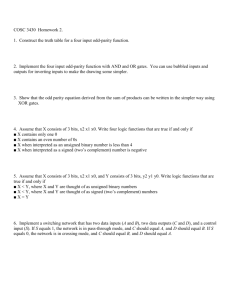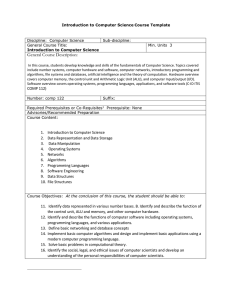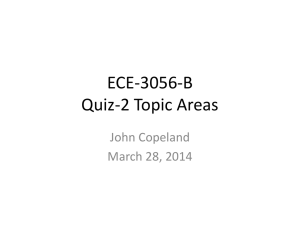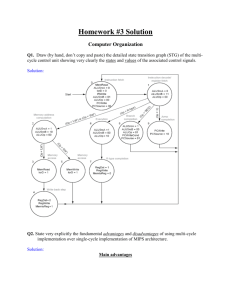18-447 Computer Architecture Lecture 4: ISA Tradeoffs (Continued) Prof. Onur Mutlu
advertisement
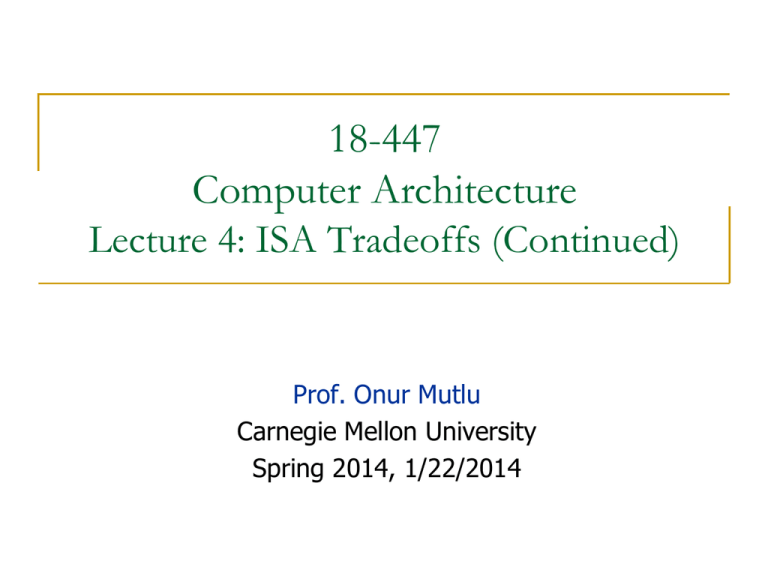
18-447
Computer Architecture
Lecture 4: ISA Tradeoffs (Continued)
Prof. Onur Mutlu
Carnegie Mellon University
Spring 2014, 1/22/2014
X86: Small Semantic Gap: String Operations
REP MOVS (DEST SRC)
How many instructions does this take in ARM and MIPS?
2
Small Semantic Gap Examples in VAX
FIND FIRST
Find the first set bit in a bit field
Helps OS resource allocation operations
SAVE CONTEXT, LOAD CONTEXT
Special context switching instructions
INSQUEUE, REMQUEUE
Operations on doubly linked list
INDEX
Array access with bounds checking
STRING Operations
Compare strings, find substrings, …
Cyclic Redundancy Check Instruction
EDITPC
Implements editing functions to display fixed format output
Digital Equipment Corp., “VAX11 780 Architecture Handbook,” 1977-78.
3
Small versus Large Semantic Gap
CISC vs. RISC
Complex instruction set computer complex instructions
Initially motivated by “not good enough” code generation
Reduced instruction set computer simple instructions
John Cocke, mid 1970s, IBM 801
Goal: enable better compiler control and optimization
RISC motivated by
Memory stalls (no work done in a complex instruction when
there is a memory stall?)
When is this correct?
Simplifying the hardware lower cost, higher frequency
Enabling the compiler to optimize the code better
Find fine-grained parallelism to reduce stalls
4
How High or Low Can You Go?
Very large semantic gap
Each instruction specifies the complete set of control signals in
the machine
Compiler generates control signals
Open microcode (John Cocke, circa 1970s)
Gave way to optimizing compilers
Very small semantic gap
ISA is (almost) the same as high-level language
Java machines, LISP machines, object-oriented machines,
capability-based machines
5
A Note on ISA Evolution
ISAs have evolved to reflect/satisfy the concerns of the day
Examples:
Limited on-chip and off-chip memory size
Limited compiler optimization technology
Limited memory bandwidth
Need for specialization in important applications (e.g., MMX)
Use of translation (in HW and SW) enabled underlying
implementations to be similar, regardless of the ISA
Concept of dynamic/static interface
Contrast it with hardware/software interface
6
Effect of Translation
One can translate from one ISA to another ISA to change
the semantic gap tradeoffs
Examples
Intel’s and AMD’s x86 implementations translate x86
instructions into programmer-invisible microoperations (simple
instructions) in hardware
Transmeta’s x86 implementations translated x86 instructions
into “secret” VLIW instructions in software (code morphing
software)
Think about the tradeoffs
7
ISA-level Tradeoffs: Instruction Length
Fixed length: Length of all instructions the same
+ Easier to decode single instruction in hardware
+ Easier to decode multiple instructions concurrently
-- Wasted bits in instructions (Why is this bad?)
-- Harder-to-extend ISA (how to add new instructions?)
Variable length: Length of instructions different
(determined by opcode and sub-opcode)
+ Compact encoding (Why is this good?)
Intel 432: Huffman encoding (sort of). 6 to 321 bit instructions. How?
-- More logic to decode a single instruction
-- Harder to decode multiple instructions concurrently
Tradeoffs
Code size (memory space, bandwidth, latency) vs. hardware complexity
ISA extensibility and expressiveness
Performance? Smaller code vs. difficult decode
8
ISA-level Tradeoffs: Uniform Decode
Uniform decode: Same bits in each instruction correspond
to the same meaning
Opcode is always in the same location
Ditto operand specifiers, immediate values, …
Many “RISC” ISAs: Alpha, MIPS, SPARC
+ Easier decode, simpler hardware
+ Enables parallelism: generate target address before knowing the
instruction is a branch
-- Restricts instruction format (fewer instructions?) or wastes space
Non-uniform decode
E.g., opcode can be the 1st-7th byte in x86
+ More compact and powerful instruction format
-- More complex decode logic
9
x86 vs. Alpha Instruction Formats
x86:
Alpha:
10
MIPS Instruction Format
R-type, 3 register operands
0
rs
rt
rd
shamt
funct
6-bit
5-bit
5-bit
5-bit
5-bit
6-bit
R-type
I-type, 2 register operands and 16-bit immediate operand
opcode
rs
rt
immediate
6-bit
5-bit
5-bit
16-bit
I-type
J-type, 26-bit immediate operand
opcode
immediate
6-bit
26-bit
J-type
Simple Decoding
4 bytes per instruction, regardless of format
must be 4-byte aligned
(2 lsb of PC must be 2b’00)
format and fields easy to extract in hardware
11
ARM
12
A Note on Length and Uniformity
Uniform decode usually goes with fixed length
In a variable length ISA, uniform decode can be a property
of instructions of the same length
It is hard to think of it as a property of instructions of different
lengths
13
A Note on RISC vs. CISC
Usually, …
RISC
Simple instructions
Fixed length
Uniform decode
Few addressing modes
CISC
Complex instructions
Variable length
Non-uniform decode
Many addressing modes
14
ISA-level Tradeoffs: Number of Registers
Affects:
Number of bits used for encoding register address
Number of values kept in fast storage (register file)
(uarch) Size, access time, power consumption of register file
Large number of registers:
+ Enables better register allocation (and optimizations) by
compiler fewer saves/restores
-- Larger instruction size
-- Larger register file size
15
ISA-level Tradeoffs: Addressing Modes
Addressing mode specifies how to obtain an operand of an
instruction
Register
Immediate
Memory (displacement, register indirect, indexed, absolute,
memory indirect, autoincrement, autodecrement, …)
More modes:
+ help better support programming constructs (arrays, pointerbased accesses)
-- make it harder for the architect to design
-- too many choices for the compiler?
Many ways to do the same thing complicates compiler design
Wulf, “Compilers and Computer Architecture,” IEEE Computer 1981
16
x86 vs. Alpha Instruction Formats
x86:
Alpha:
17
x86
register
indirect
absolute
register +
displacement
register
18
x86
indexed
(base +
index)
scaled
(base +
index*4)
19
X86 SIB-D Addressing Mode
x86 Manual Vol. 1, page 3-22 -- see course resources on website
Also, see Section 3.7.3 and 3.7.5
20
X86 Manual: Suggested Uses of Addressing Modes
x86 Manual Vol. 1, page 3-22 -- see course resources on website
Also, see Section 3.7.3 and 3.7.5
21
X86 Manual: Suggested Uses of Addressing Modes
x86 Manual Vol. 1, page 3-22 -- see course resources on website
Also, see Section 3.7.3 and 3.7.5
22
Other Example ISA-level Tradeoffs
Condition codes vs. not
VLIW vs. single instruction
Precise vs. imprecise exceptions
Virtual memory vs. not
Unaligned access vs. not
Hardware interlocks vs. software-guaranteed interlocking
Software vs. hardware managed page fault handling
Cache coherence (hardware vs. software)
…
23
Back to Programmer vs. (Micro)architect
Many ISA features designed to aid programmers
But, complicate the hardware designer’s job
Virtual memory
vs. overlay programming
Should the programmer be concerned about the size of code
blocks fitting physical memory?
Addressing modes
Unaligned memory access
Compile/programmer needs to align data
24
MIPS: Aligned Access
MSB
byte-2
byte-1
byte-0
byte-7
byte-6
byte-5
byte-4
LSB
LW/SW alignment restriction: 4-byte word-alignment
byte-3
not designed to fetch memory bytes not within a word boundary
not designed to rotate unaligned bytes into registers
Provide separate opcodes for the “infrequent” case
A
B
C
D
LWL rd 6(r0)
byte-6
byte-5
byte-4
D
LWR rd 3(r0)
byte-6
byte-5
byte-4
byte-3
LWL/LWR is slower
Note LWL and LWR still fetch within word boundary
25
X86: Unaligned Access
LD/ST instructions automatically align data that spans a
“word” boundary
Programmer/compiler does not need to worry about where
data is stored (whether or not in a word-aligned location)
26
X86: Unaligned Access
27
Aligned vs. Unaligned Access
Pros of having no restrictions on alignment
Cons of having no restrictions on alignment
Filling in the above: an exercise for you…
28
Implementing the ISA:
Microarchitecture Basics
29
How Does a Machine Process Instructions?
What does processing an instruction mean?
Remember the von Neumann model
A = Architectural (programmer visible) state before an
instruction is processed
Process instruction
A’ = Architectural (programmer visible) state after an
instruction is processed
Processing an instruction: Transforming A to A’ according to
the ISA specification of the instruction
30
The “Process instruction” Step
ISA specifies abstractly what A’ should be, given an
instruction and A
It defines an abstract finite state machine where
From ISA point of view, there are no “intermediate states”
between A and A’ during instruction execution
State = programmer-visible state
Next-state logic = instruction execution specification
One state transition per instruction
Microarchitecture implements how A is transformed to A’
There are many choices in implementation
We can have programmer-invisible state to optimize the speed of
instruction execution: multiple state transitions per instruction
Choice 1: A A’ (transform A to A’ in a single clock cycle)
Choice 2: A A+MS1 A+MS2 A+MS3 A’ (take multiple clock
cycles to transform A to A’)
31
A Very Basic Instruction Processing Engine
Each instruction takes a single clock cycle to execute
Only combinational logic is used to implement instruction
execution
No intermediate, programmer-invisible state updates
A = Architectural (programmer visible) state
at the beginning of a clock cycle
Process instruction in one clock cycle
A’ = Architectural (programmer visible) state
at the end of a clock cycle
32
A Very Basic Instruction Processing Engine
Single-cycle machine
ANext
Combinational
Logic
Sequential
Logic
(State)
A
What is the clock cycle time determined by?
What is the critical path of the combinational logic
determined by?
33
Remember: Programmer Visible (Architectural) State
M[0]
M[1]
M[2]
M[3]
M[4]
Registers
- given special names in the ISA
(as opposed to addresses)
- general vs. special purpose
M[N-1]
Memory
Program Counter
array of storage locations
indexed by an address
memory address
of the current instruction
Instructions (and programs) specify how to transform
the values of programmer visible state
34
Single-cycle vs. Multi-cycle Machines
Single-cycle machines
Each instruction takes a single clock cycle
All state updates made at the end of an instruction’s execution
Big disadvantage: The slowest instruction determines cycle time
long clock cycle time
Multi-cycle machines
Instruction processing broken into multiple cycles/stages
State updates can be made during an instruction’s execution
Architectural state updates made only at the end of an instruction’s
execution
Advantage over single-cycle: The slowest “stage” determines cycle time
Both single-cycle and multi-cycle machines literally follow the
von Neumann model at the microarchitecture level
35
Instruction Processing “Cycle”
Instructions are processed under the direction of a “control
unit” step by step.
Instruction cycle: Sequence of steps to process an instruction
Fundamentally, there are six phases:
Fetch
Decode
Evaluate Address
Fetch Operands
Execute
Store Result
Not all instructions require all six stages (see P&P Ch. 4)
36
Instruction Processing “Cycle” vs. Machine Clock Cycle
Single-cycle machine:
All six phases of the instruction processing cycle take a single
machine clock cycle to complete
Multi-cycle machine:
All six phases of the instruction processing cycle can take
multiple machine clock cycles to complete
In fact, each phase can take multiple clock cycles to complete
37
Instruction Processing Viewed Another Way
Instructions transform Data (AS) to Data’ (AS’)
This transformation is done by functional units
Units that “operate” on data
These units need to be told what to do to the data
An instruction processing engine consists of two components
Datapath: Consists of hardware elements that deal with and
transform data signals
functional units that operate on data
hardware structures (e.g. wires and muxes) that enable the flow of
data into the functional units and registers
storage units that store data (e.g., registers)
Control logic: Consists of hardware elements that determine
control signals, i.e., signals that specify what the datapath
elements should do to the data
38
Single-cycle vs. Multi-cycle: Control & Data
Single-cycle machine:
Multi-cycle machine:
Control signals are generated in the same clock cycle as data
signals are operated on
Everything related to an instruction happens in one clock cycle
Control signals needed in the next cycle can be generated in
the previous cycle
Latency of control processing can be overlapped with latency
of datapath operation
We will see the difference clearly in microprogrammed
multi-cycle microarchitecture
39
Many Ways of Datapath and Control Design
There are many ways of designing the data path and
control logic
Single-cycle, multi-cycle, pipelined datapath and control
Single-bus vs. multi-bus datapaths
Hardwired/combinational vs. microcoded/microprogrammed
control
See your homework 2 question
Control signals generated by combinational logic versus
Control signals stored in a memory structure
Control signals and structure depend on the datapath
design
40
Flash-Forward: Performance Analysis
Execution time of an instruction
Execution time of a program
Sum over all instructions [{CPI} x {clock cycle time}]
{# of instructions} x {Average CPI} x {clock cycle time}
Single cycle microarchitecture performance
{CPI} x {clock cycle time}
CPI = 1
Clock cycle time = long
Multi-cycle microarchitecture performance
CPI = different for each instruction
Average CPI hopefully small
Clock cycle time = short
Now, we have
two degrees of freedom
to optimize independently
41
A Single-Cycle Microarchitecture
A Closer Look
42
Remember…
Single-cycle machine
ASNext
Combinational
Logic
Sequential
Logic
(State)
AS
43
Let’s Start with the State Elements
Data and control inputs
on
5
Register
numbers
3
Read
register 1
5
Read
register 2
Registers
5 Write
Add Sum register
PC
Instruction
ion
ory
Data
Write
data
Read
data 1
Data
AL
Read
data 2
RegWrite
uction memory
b. Program counter
c. Adder
a. Registers
b
MemWrite
Instruction
address
Address
PC
Read
data
Instruction
Instruction
memory
a. Instruction memory
Add Sum
Write
data
b. Program counter
Data
memory
MemRead
a. Data memory unit
**Based on original figure from [P&H CO&D, COPYRIGHT 2004 Elsevier. ALL RIGHTS RESERVED.]
16
Sign
extend
c. Adder
b. Sign-exten
44
For Now, We Will Assume
“Magic” memory and register file
Combinational read
output of the read data port is a combinational function of the
register file contents and the corresponding read select port
Synchronous write
the selected register is updated on the positive edge clock
transition when write enable is asserted
Cannot affect read output in between clock edges
Can affect read output at clock edges (but who cares?)
Single-cycle, synchronous memory
Contrast this with memory that tells when the data is ready
i.e., Ready bit: indicating the read or write is done
45
Instruction Processing
5 generic steps (P&H)
Instruction fetch (IF)
Instruction decode and register operand fetch (ID/RF)
Execute/Evaluate memory address (EX/AG)
Memory operand fetch (MEM)
Store/writeback result (WB)
WB
IF
Data
Register #
PC
Address
Instruction
memory
Instruction
Registers
ALU
Address
Register #
ID/RF
Register #
Data
memory
EX/AG
Data
**Based on original figure from [P&H CO&D, COPYRIGHT 2004 Elsevier. ALL RIGHTS RESERVED.]
MEM
46
What Is To Come: The Full Datapath
Instruction [25– 0]
26
Shift
left 2
PCSrc1=Jump
Jump address [31– 0]
28
PC+4 [31– 28]
ALU
Add result
Add
4
Instruction [31– 26]
Control
Instruction [25– 21]
PC
Read
address
Instruction
memory
Instruction [15– 11]
M
u
x
1
0
PCSrc2=Br Taken
Shift
left 2
RegDst
Jump
Branch
MemRead
MemtoReg
ALUOp
MemWrite
ALUSrc
RegWrite
0
M
u
x
1
Read
data 1
Read
register 2
Registers Read
Write
data 2
register
0
M
u
x
1
Write
data
Zero
bcond
ALU ALU
result
Address
Write
data
Instruction [15– 0]
1
M
u
x
Read
register 1
Instruction [20– 16]
Instruction
[31– 0]
0
16
Sign
extend
Read
data
Data
memory
1
M
u
x
0
32
ALU
control
ALU operation
Instruction [5– 0]
**Based on original figure from [P&H CO&D, COPYRIGHT 2004 Elsevier.
ALL RIGHTS RESERVED.]
47
JAL, JR, JALR omitted
Single-Cycle Datapath for
Arithmetic and Logical Instructions
48
R-Type ALU Instructions
Assembly (e.g., register-register signed addition)
ADD rdreg rsreg rtreg
Machine encoding
0
rs
rt
rd
0
ADD
6-bit
5-bit
5-bit
5-bit
5-bit
6-bit
R-type
Semantics
if MEM[PC] == ADD rd rs rt
GPR[rd] GPR[rs] + GPR[rt]
PC PC + 4
49
ALU Datapath
Add
4
25:21
PC
Read
address
20:16
Instruction
Instruction
15:11
Instruction
memory
3
Read
register 1
Read
register 2
Registers
Write
register
Write
data
ALU operation
Read
data 1
Zero
ALU ALU
result
Read
data 2
RegWrite
1
IF
if MEM[PC] == ADD rd rs rt
GPR[rd] GPR[rs] + GPR[rt]
PCfrom
+ 4 2004 Elsevier. ALL RIGHTS RESERVED.]
**Based on original figure
[P&HPC
CO&D, COPYRIGHT
**Based on original figure from [P&H CO&D, COPYRIGHT 2004 Elsevier. ALL RIGHTS RESERVED.]
ID
EX
MEM WB
Combinational
state update logic
50
I-Type ALU Instructions
Assembly (e.g., register-immediate signed additions)
ADDI rtreg rsreg immediate16
Machine encoding
ADDI
rs
rt
immediate
6-bit
5-bit
5-bit
16-bit
I-type
Semantics
if MEM[PC] == ADDI rt rs immediate
GPR[rt] GPR[rs] + sign-extend (immediate)
PC PC + 4
51
Datapath for R and I-Type ALU Insts.
Add
4
PC
25:21
Read
address
20:16
Instruction
Instruction
memory
Instruction
15:11
RegDest
isItype
3
Read
register 1
Read
register 2
Registers
Write
register
Write
data
Zero
ALU ALU
result
GPR[rt] GPR[rs] + sign-extend (immediate)
PC PC + 4
**Based on original figure from [P&H CO&D, COPYRIGHT 2004 Elsevier. ALL RIGHTS RESERVED.]
Address
Read
data 2
Write
data
ALUSrc
Sign
extend
IF
if MEM[PC] == ADDI rt rs immediate
Mem
Read
data 1
RegWrite
116
ALU operation
32
Data
memo
isItype
ID
Mem
EX
MEM WB
Combinational
state update logic 52
Single-Cycle Datapath for
Data Movement Instructions
53
Load Instructions
Assembly (e.g., load 4-byte word)
LW rtreg offset16 (basereg)
Machine encoding
LW
base
rt
offset
6-bit
5-bit
5-bit
16-bit
I-type
Semantics
if MEM[PC]==LW rt offset16 (base)
EA = sign-extend(offset) + GPR[base]
GPR[rt] MEM[ translate(EA) ]
PC PC + 4
54
LW Datapath
Add
add
4
PC
Read
register 1
Read
address
Instruction
Instruction
Instruction
memory
Read
register 2
Registers
Write
register
Write
data
RegDest
isItype
3
MemWrite
Read
data 1
Zero
ALU ALU
result
Address
Address
Read
data 2
RegWrite
116
MemWrite
ALU operation
Write
data
ALUSrc
Sign
extend
if MEM[PC]==LW rt offset16 (base)
EA = sign-extend(offset) + GPR[base]
GPR[rt] MEM[ translate(EA) ]
PC PC + 4
32
Read
data
Read
data
16
Data
Write
data Data memory
memory
MemRead
isItype
MemRead
a. Data memory unit
IF
ID
EX
MEM WB
Combinational
state update logic 55
b. Si
Store Instructions
Assembly (e.g., store 4-byte word)
SW rtreg offset16 (basereg)
Machine encoding
SW
base
rt
offset
6-bit
5-bit
5-bit
16-bit
I-type
Semantics
if MEM[PC]==SW rt offset16 (base)
EA = sign-extend(offset) + GPR[base]
MEM[ translate(EA) ] GPR[rt]
PC PC + 4
56
SW Datapath
Add
add
4
PC
Read
register 1
Read
address
Instruction
Instruction
Instruction
memory
Read
register 2
Registers
Write
register
Write
data
RegDest
isItype
3
MemWrite
Read
data 1
Zero
ALU ALU
result
Address
Address
Read
data 2
Write
data
RegWrite
016
MemWrite
ALU operation
ALUSrc
Sign
extend
if MEM[PC]==SW rt offset16 (base)
EA = sign-extend(offset) + GPR[base]
MEM[ translate(EA) ] GPR[rt]
PC PC + 4
32
Read
data
Read
data
16
Data
Write
data Data memory
memory
MemRead
isItype
MemRead
a. Data memory unit
IF
ID
EX
MEM WB
Combinational
state update logic 57
b. Si
Load-Store Datapath
Add
4
PC
add
Read
register 1
Read
address
Instruction
Instruction
Instruction
memory
Read
register 2
Registers
Write
register
Write
data
RegDest
isItype
3
MemWrite
Read
data 1
Zero
ALU ALU
result
Read
data
Address
Read
data 2
RegWrite
!isStore
16
isStore
ALU operation
Sign
extend
32
ALUSrc
isItype
Write
data
Data
memory
MemRead
isLoad
**Based on original figure from [P&H CO&D, COPYRIGHT
2004 Elsevier. ALL RIGHTS RESERVED.]
58
Datapath for Non-Control-Flow Insts.
Add
4
PC
Read
register 1
Read
address
Instruction
Instruction
Instruction
memory
Read
register 2
Registers
Write
register
Write
data
RegDest
isItype
3
MemWrite
Read
data 1
Zero
ALU ALU
result
Read
data
Address
Read
data 2
RegWrite
!isStore
16
isStore
ALU operation
Sign
extend
32
ALUSrc
isItype
Write
data
Data
memory
MemRead
isLoad
MemtoReg
isLoad
**Based on original figure from [P&H CO&D, COPYRIGHT 2004 Elsevier. ALL RIGHTS RESERVED.]
59
Single-Cycle Datapath for
Control Flow Instructions
60
Unconditional Jump Instructions
Assembly
J immediate26
Machine encoding
J
immediate
6-bit
26-bit
J-type
Semantics
if MEM[PC]==J immediate26
target = { PC[31:28], immediate26, 2’b00 }
PC target
61
Unconditional Jump Datapath
isJ
Add
PCSrc
4
PC
Read
register 1
Read
address
Instruction
concat
Read
register 2
Registers
Write
register
Instruction
Instruction
memory
?
Write
data
3
XALU operation
MemWrite
Read
data 1
Zero
ALU ALU
result
**Based on original figure from [P&H CO&D, COPYRIGHT
2004 Elsevier. ALL RIGHTS RESERVED.]
if MEM[PC]==J immediate26
PC = { PC[31:28], immediate26, 2’b00 }
Read
data
Address
Read
data 2
RegWrite
0 16
0
Sign
extend
32
ALUSrc
X
Write
data
Data
memory
MemRead
0
62
What about JR, JAL, JALR?
Conditional Branch Instructions
Assembly (e.g., branch if equal)
BEQ rsreg rtreg immediate16
Machine encoding
BEQ
rs
rt
immediate
6-bit
5-bit
5-bit
16-bit
I-type
Semantics (assuming no branch delay slot)
if MEM[PC]==BEQ rs rt immediate16
target = PC + 4 + sign-extend(immediate) x 4
if GPR[rs]==GPR[rt] then PC target
else
PC PC + 4
63
Conditional Branch Datapath (For You to Fix)
watch out
PC + 4 from instruction datapath
Add
PCSrc
Add Sum
4
PC
Shift
left 2
Read
address
Instruction
concat
Instruction
memory
Instruction
Branch target
sub
ALU operation
3
Read
register 1
Read
register 2
Registers
Write
register
Write
data
Read
data 1
ALU bcond
Zero
To branch
control logic
Read
data 2
RegWrite
0
16
Sign
extend
32
**Based on original figure from [P&H CO&D, COPYRIGHT 2004 Elsevier. ALL RIGHTS RESERVED.]
64
How to uphold the delayed branch semantics?
Putting It All Together
Instruction [25– 0]
26
Shift
left 2
PCSrc1=Jump
Jump address [31– 0]
28
PC+4 [31– 28]
ALU
Add result
Add
4
Instruction [31– 26]
Control
Instruction [25– 21]
PC
Read
address
Instruction
memory
Instruction [15– 11]
M
u
x
1
0
PCSrc2=Br Taken
Shift
left 2
RegDst
Jump
Branch
MemRead
MemtoReg
ALUOp
MemWrite
ALUSrc
RegWrite
0
M
u
x
1
Read
data 1
Read
register 2
Registers Read
Write
data 2
register
0
M
u
x
1
Write
data
Zero
bcond
ALU ALU
result
Address
Write
data
Instruction [15– 0]
1
M
u
x
Read
register 1
Instruction [20– 16]
Instruction
[31– 0]
0
16
Sign
extend
Read
data
Data
memory
1
M
u
x
0
32
ALU
control
ALU operation
Instruction [5– 0]
**Based on original figure from [P&H CO&D, COPYRIGHT 2004 Elsevier.
ALL RIGHTS RESERVED.]
65
JAL, JR, JALR omitted

